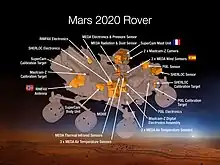Abigail Allwood
Abigail Allwood is an Australian geologist and astrobiologist at the NASA Jet Propulsion Laboratory (JPL) who studies stromatolites, detection of life on other planets, and evolution of life on early Earth. Her early work gained notability for finding evidence of life in 3.45 billion year old stromatolites in the Pilbara formation in Australia, which was featured on the cover of the journal Nature.[1][2] She is now one of seven principal investigators on the Mars Rover 2020 team searching for evidence of life on Mars using the Planetary Instrument for X-Ray Lithochemistry (PIXL).[3][4] Allwood is the first female and first Australian principal investigator on a NASA Mars mission.[5]
Abigail Allwood | |
|---|---|
| Citizenship | Australian |
| Education | Ph.D. Earth Science
B. App. Sc. (Honours First Class) (Geoscience) B. App. Sc (Geoscience) with Distinction |
| Alma mater | Macquarie University Queensland University of Technology |
| Known for |
|
| Scientific career | |
| Institutions | Astrobiologist in NASA's Jet Propulsion Laboratory |
Early life and education
Allwood grew up in Brisbane, Australia, and was inspired by Carl Sagan and his description of the Voyager missions in the series Cosmos.[1] She attended high school at Somerville House and graduated in 1990.[6] She went on to accomplish an undergraduate degree in geosciences, and completed her PhD at Macquarie University in Australia in 2006 under the advisement of Dr. Malcolm Walter.[3] During her PhD, she published on 3.45 billion years old stromatolites in the Pilbara formation, describing the diversity of early life on the Archean Earth.[7] In 2006 Allwood's research into micro fossils won her a position at California Institute of Technology in Pasadena, working with geologist John Grotzinger.[8] She went on to do postdoctoral work at JPL, where she is currently a principal investigator on the Mars Rover mission set for 2020.[9]
Research

Allwood has published extensively on characterizing stromatolites using various techniques.[7][10][11] In 2018, she published a study of 3.7 billion years old metasedimentary rocks in the Isua formation in Greenland. In this study, she and colleagues analyzed structures which were previously determined to be biogenic stromatolites.[12][13] However, Allwood concluded that the putatively biogenic structures were structures caused by deformation, receiving media attention.[14][15]
Allwood led the research and development of the instrument that scans rocks for chemical signatures of life – the PIXL, miniaturising a similar instrument used to analyse the Pilbara rocks, for inclusion on the Mars Rover searching for chemical traces left by ancient microbes.[16]
She has also been involved in other aspects of the Rover missions to collect rock samples on Mars, and return them to Earth for analysis.[17]
Allwood's PIXL team of engineers at JPL and the Queensland University of Technology (QUT) have also created software to process data sent from Mars.[4]
Awards
- Science and Technology Award 2020 - Finalist [18]
- Advance Science and Technology Award 2020 - Winner [18]
- Advance Global Australian Award 2020 - Winner [18]
- Queensland University of Technology Alumnus of the year [19]
- Lew Allen Award for Excellence 2013 [20][21]
- JPL Outstanding Postdoc Award 2008 [20]
References
- Parker, Laura (June 2018). "Can Abigail Allwood Find Life on Mars?". The Atlantic. ISSN 1072-7825. Retrieved 5 December 2018.
- "Volume 441 Issue 7094, 8 June 2006". nature.com. Retrieved 5 December 2018.
- "Is there life on Mars?". BBC Culture. Retrieved 5 December 2018.
- "'I can't believe it': This Australian's invention is landing on Mars this week". ABC News. 16 February 2021. Retrieved 7 October 2023.
- Moore, Nicky Phillips, Tony (5 August 2014). "Australian scientist Abigail Allwood first woman to lead project team for life on Mars". The Sydney Morning Herald. Retrieved 5 December 2018.
{{cite web}}: CS1 maint: multiple names: authors list (link) - "Alumnae". Somerville House. Retrieved 7 October 2023.
- Burch, Ian W.; Marshall, Craig P.; Kamber, Balz S.; Walter, Malcolm R.; Allwood, Abigail C. (2006). "Stromatolite reef from the Early Archaean era of Australia". Nature. 441 (7094): 714–718. Bibcode:2006Natur.441..714A. doi:10.1038/nature04764. ISSN 1476-4687. PMID 16760969. S2CID 4417746.
- "Abigail Allwood: Tooling up for Mars". cosmosmagazine.com. 1 February 2016. Retrieved 7 October 2023.
- "Abigail Allwood". science.jpl.nasa.gov. Retrieved 5 December 2018.
- Kanik, Isik; Coleman, Max L.; Anderson, Mark S.; Burch, Ian W.; Knoll, Andrew H.; Grotzinger, John P.; Allwood, Abigail C. (16 June 2009). "Controls on development and diversity of Early Archean stromatolites". Proceedings of the National Academy of Sciences. 106 (24): 9548–9555. Bibcode:2009PNAS..106.9548A. doi:10.1073/pnas.0903323106. ISSN 1091-6490. PMC 2700989. PMID 19515817.
- Allwood, Abigail C.; Kamber, Balz S.; Walter, Malcolm R.; Burch, Ian W.; Kanik, Isik (15 February 2010). "Trace elements record depositional history of an Early Archean stromatolitic carbonate platform". Chemical Geology. 270 (1–4): 148–163. Bibcode:2010ChGeo.270..148A. doi:10.1016/j.chemgeo.2009.11.013. ISSN 0009-2541.
- Heirwegh, Christopher M.; Hurowitz, Joel A.; Flannery, David T.; Rosing, Minik T.; Allwood, Abigail C. (2018). "Reassessing evidence of life in 3,700-million-year-old rocks of Greenland". Nature. 563 (7730): 241–244. Bibcode:2018Natur.563..241A. doi:10.1038/s41586-018-0610-4. ISSN 1476-4687. PMID 30333621. S2CID 52987320.
- Chivas, Allan R.; Kranendonk, Martin J. Van; Friend, Clark R. L.; Bennett, Vickie C.; Nutman, Allen P. (2016). "Rapid emergence of life shown by discovery of 3,700-million-year-old microbial structures". Nature. 537 (7621): 535–538. Bibcode:2016Natur.537..535N. doi:10.1038/nature19355. ISSN 1476-4687. PMID 27580034. S2CID 205250494.
- Maya Wei-Haas (17 October 2018). "'World's oldest fossils' may just be pretty rocks". National Geographic. Retrieved 5 December 2018.
- Yong, Ed (17 October 2018). "Oops, the Oldest Fossils Ever Found Might Be Just Rocks". The Atlantic. Retrieved 5 December 2018.
- "Abigail Allwood: Tooling up for Mars". cosmosmagazine.com. 1 February 2016. Retrieved 7 October 2023.
- "What has Perseverance found in two years on Mars?". 17 February 2023. Retrieved 7 October 2023.
- "Dr Abigail Allwood". Advance The Global Australian Network. Retrieved 7 October 2023.
- "Abigail Allwood: Tooling up for Mars". cosmosmagazine.com. 1 February 2016. Retrieved 7 October 2023.
- "JPL Science: Abigail Allwood". science.jpl.nasa.gov. Retrieved 7 October 2023.
- Moore, Tony (4 August 2014). "Brisbane woman leads NASA's search for life on Mars". The Sydney Morning Herald. Retrieved 7 October 2023.